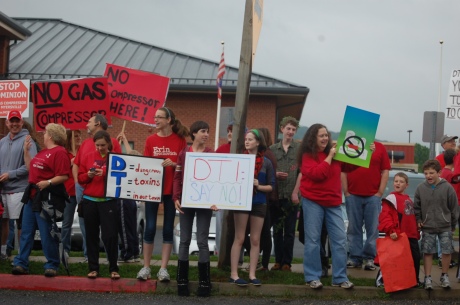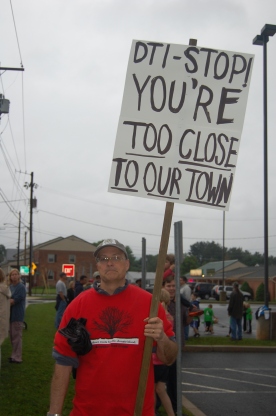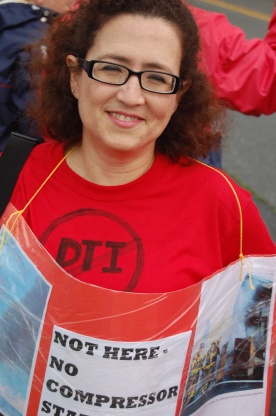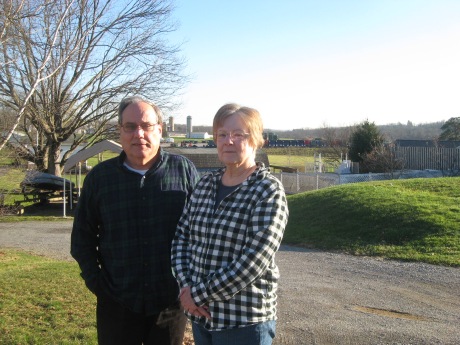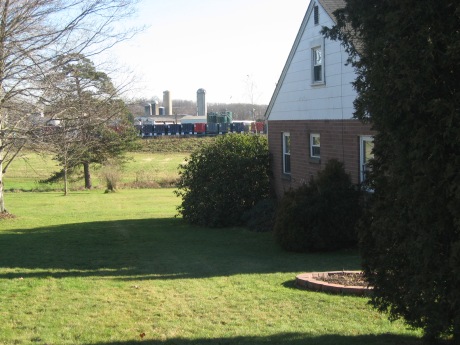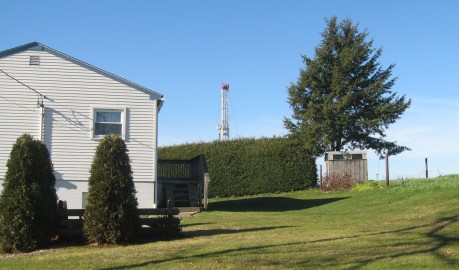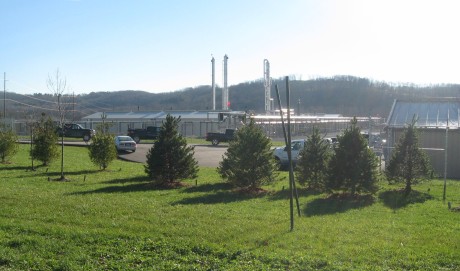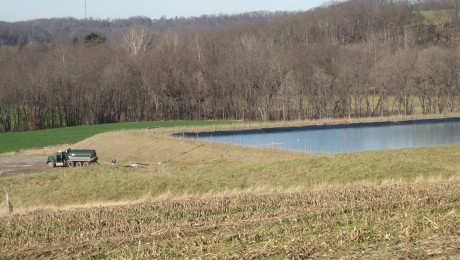fracking’s collateral damage
December 31, 2012
Myersville, population 1,600, is the collateral damage in the battle over fracking.
Fracking for natural gas won’t happen in Maryland for at least a couple years. If the General Assembly approves a proposed moratorium, fracking won’t be allowed here unless it can be shown to be safe. Nevertheless, Dominion Transmission Inc. (DTI) received federal approval Dec. 20 to construct a 16,000-horsepower compressor station in this rural Frederick County town so it can transport fracked gas through Maryland to its 1.5 million customers in the region and beyond.
The Myersville Town Council, which will discuss the ruling at a workshop Jan. 2, and residents have 30 days to decide what to do. Myersville Citizens for a Rural Community, which started in October 2011 and has set up a website and Facebook page to educate and update residents, has spent $2,400 for legal assistance and will need to raise $1,500 to appeal the ruling. It is up against the relatively bottomless pockets of DTI.
Compressor stations are needed every 40 to 100 miles along a pipeline to keep natural gas flowing at the proper pressure. As industry extracts more natural gas using the technique known as fracking, it will alarm more towns with plans for compressor stations. And these compressor stations will be in addition to the drill rigs, drill pads, chemically infused water, frack ponds holding toxic waste, earthquakes caused by reinjecting wastewater, more pipelines and truck traffic already imposed on rural communities.
Compressor stations can be noisy, contribute to air pollution and occasionally blow up. In November 2011, 40 to 50 homes were evacuated after a fire broke out in a compressor station in Artemas, Pa. Here’s an explosion near Dimock, Pa., and one in Falcon, Wyo.
More than 650 Myersville residents signed a petition against the compressor station, and more than 750 wrote letters to the Federal Energy Regulatory Commission (FERC), the agency charged with approving or denying the station. The mayor, the Town Council and the town Planning Commission voted to reject DTI’s application. In the local newspaper, following the council’s unanimous vote, Councilman Mark Flynn said: “It’s important to note that over and over, DTI said they want to be a good neighbor, and this is an opportunity for them be a good neighbor. The people have spoken, the Town Council has spoken, the Planning Commission has spoken. If they now try to force it down our throats, they’re proving they are not a good neighbor. They are a neighborhood bully.”
The Planning Commission called the compressor station a nuisance, based on the dictionary definition: “annoying, unpleasant or obnoxious.” One commission member said it requires many more safety features than required by other allowed uses in the area and so was “inherently hazardous.” The commission also said that the zoning for the site was designed to attract businesses and local jobs, not an industrial site with no long-term job opportunities.
Democratic Sens. Barbara Mikulski and Benjamin Cardin wrote letters on behalf of the residents and mentioned the compressor station fire in Artemas. Maryland state Sen. David Brinkley (R) wrote to FERC as well, noting that the state has invested millions in agricultural preservation easements as well as numerous state parks in the area.
FERC, however, can and does overrule local wishes and preempt local and state regulations. In its decision, FERC said that it “encourages cooperation between interstate pipeline companies and local authorities,” but local and state municipalities cannot “prohibit or unreasonably delay the construction or operation of facilities approved by the Commission.” FERC found that the project would pose no harm or “significant impacts” to the community or environment of Myersville. Although the community found the project “highly controversial,” FERC disagreed. Under the commissioners’ legal definition, the project is not considered controversial “merely because individuals or groups vigorously oppose, or have raised questions about, an action. Here, we find that no substantial disputes exist as to the effects of the project.”
The compressor station would be located south of Interstate 70, which cuts through the southern portion of Myersville. The site is adjacent to the wastewater treatment plant for the town, a mile from Myersville Elementary School and a mile from the fire station that contains the town’s evacuation shelter. It’s less than two miles from an arts-centered teacher training school that doesn’t even use markers that emit volatile organic compounds and a third of a mile from a pediatric medical practice. All of Myersville is within two miles of the compressor station. The surrounding area is mostly farms and state parks.
In its application, DTI said that the compressor station would annually emit 23.53 tons of nitrogen oxide (NOx), 5.32 tons of carbon monoxide (CO), 1.14 tons of volatile organic compounds, 0.25 tons of sulfur dioxide (SO2), 2.83 tons of particulate matter, 0.93 tons of hazardous air pollutants (including formaldehyde) and 53,892 tons of CO2 and its equivalents.
The facility, DTI says, will be equipped with a catalyst to control hazardous air pollutants, including carcinogens such as benzene and formaldehyde. As a result, it says, emission rates will be even lower than typical gas-burning facilities and well below levels deemed safe by the Environmental Protection Agency.
But the compressor station will, for example, more than double the annual nitrogen dioxide (NO2) pollution in Myersville. (NO2 at high levels has been linked to sudden infant death syndrome.) Much of the existing NOx and NO2 pollution that settles into the valley is from traffic on I-70. SO2, along with NOx, is a principal contributor to acid rain. SO2 has a “pungent and suffocating odor” and can react with other chemicals to form particulate pollution. Adults and children with asthma or heart or lung disease are sensitive to SO2 exposure, especially if they are active outdoors. (Tox Town, on the U.S. National Library of Medicine site, has complete information on harm from exposures to all these pollutants. Communities in Pennsylvania are starting to worry about the cumulative harm from multiple compressor stations.)
Residents are also concerned about periodic blowdowns, or venting of natural gas to relieve pressure. DTI “officials have said the blowdowns … do and will occur,” said Ann Marie Nau, a member of Myersville Citizens for a Rural Community. “Their own superintendent described these as ‘violent’ and ‘ugly’ events. I am concerned about the proximity of the school to the compressor station when one of these violent events occurs.” Here’s a blowdown that lasted 50 minutes at the Williams Central compressor station in Brooklyn, Pa.
Not to worry, though. DTI told the town Planning Commission that it could make the compressor station look like a barn.
Myersville residents have followed intently the 16-month struggle by residents of Minisink, N.Y., to stop two 6,130-horsepower compressor stations. Like Maryland, New York has yet to approve fracking, but the infrastructure spreads. FERC, in a 3-2 vote, approved this compressor station, despite protests from residents, many of whom are former first responders from New York City who moved to rural Minisink to recover after the attacks of Sept. 11, 2001. (The dissenting commissioners, Chairman Jon Wellinghoff and Cheryl A. LaFleur, voted to approve the station in Myersville.) In October, Minisink residents picketed as construction began. FERC has denied them a rehearing, so they will challenge the decision in the U.S. Court of Appeals. (Information about Minisink residents, including an excellent video, is here.)
DTI initially considered placing its Frederick County compressor station in Middletown or Jefferson, but after meeting resistance there, it settled on Myersville. “The gas companies and FERC seem to pit the communities against each other,” Ann said. “No one wants it in their community, so they foist it on the next one.” Ann, who had never been politically active before this fight, said one Middletown resident even surveyed surrounding towns, “finding available properties, calculating the distance from the existing pipeline, creating a 1- to 5-star rating system. . . . Obviously, he gave the Middletown property a negative rating. He rated this Myersville site a 5. And to be perfectly fair, commentators in the Myersville docket have pointed out the suitability of the Middletown site versus the Myersville site.”
DTI sent notices about an August 2011 informational meeting only to residents within a half-mile of the site. Ann, who lives outside the magic half-mile line, said she and her husband learned about the compressor station when someone from Myersville Citizens for a Rural Community dropped off a flier for a meeting in November 2011 with DTI and FERC. “We were shocked to find that it was standing-room only,” she said. By August 2012, the Town Council had voted to reject the compressor station as incompatible with its codes, only to be overruled by FERC last week.
In her research about the station, Ann said she “was struck by one thing: Slick hyrdrofracking is scary. And dangerous. And, while for now I am not faced with a fracking well in my community, these wells are in other communities, and they are adversely affecting the health, well-being and safety of individuals no different than myself or my family. It is not okay. And then there are the issues as they relate to the environment, climate change and water consumption/contamination. . . . Understand one thing, I hope that I am wrong about fracking. As Ronald Reagan said, ‘Trust, but verify.’ So far, the gas companies cannot verify that what they are doing is safe; therefore, I do not trust them.”
Myersville residents will “continue to battle for their community and the health and safety of their children,” Ann said. They contend, for starters, that the FERC ruling fails to address Clean Air Act rules and has flaws in its historic impact study. “Frankly,” she said, “it seems that FERC places the onus on the citizens to find flaws in the projects as opposed to conducting any real analysis, leaving citizens to battle not just big gas but big government.”
–elisabeth hoffman
top 10 signs of a climate apocalypse
December 27, 2012
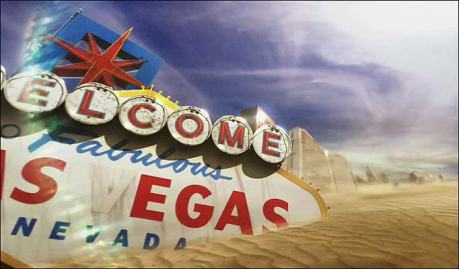
The movie ‘The Age of Stupid’ shows the fate of Las Vegas and the world in 2055 if we do nothing to stop climate change. // photo from ‘The Age of Stupid’
So, we’re still here. The Mayans weren’t signaling an end of the world, only an end to an era.
On the other hand, that means we are not off the hook on climate change, which could hasten the end of the world as we know it.
To close out the year, here’s a list in no particular order of the top 10 warning signals. … Well, I don’t know if they are the top 10, but they are 10 that sure alarmed me. Feel free to add reports you’ve seen in the comments:
1. A report commissioned by the World Bank outlines the severe effects from a 4-degree-Celsius temperature rise even if countries meet current pledges to cut emissions. If they fail that, the results would be even worse. World Bank President Jim Yong Kim said: “This report is a sobering look at what a 4-degree-Celsius warmer world would look like. There would be massive disruption in some of our most basic systems—water supply, the viability of coastal cities, entire populations that live in low-lying areas. But moreover, it has implications for disaster risk management. It has implications for food supply. And most importantly for us, the worst impacts are going to happen in the poorest countries, to the poorest people.” Read the World Bank report here or Amy Goodman’s segment on the report here.
2. Last month, the U.N. World Meteorological Organization reported that greenhouse gas emission in 2011 broke all records. “Between 1990 and 2011 there was a 30% increase in radiative forcing—the warming effect on our climate—because of carbon dioxide (CO2) and other heat-trapping, long-lived gases,” the report said. The report also said that methane in the atmosphere reached “a new high of about 1813 parts per billion (ppb) in 2011, or 259% of the pre-industrial level, due to increased emissions from anthropogenic sources.” Although methane levels had been leveling off, since 2007 they have been on the rise again. (That is also the time frame for the boom in fracking, but the report doesn’t list a cause). Methane lasts about a dozen years in the atmosphere, compared with 100 years for CO2, but it holds far more heat-trapping gases while there. Compared over 100 years, it’s 21 times worse for the climate than CO2; compared over 20 years, it’s 72 times worse.
5. NOAA’s Arctic Report Card reported a “rare, nearly ice-sheet-wide [surface] melt” of Greenland’s glacier this summer. The annual melt season was also the longest on record. When Greenland surface ice thaws, it reflects less sunlight, which in turn accelerates warming.
6. Arctic sea ice also hit a record low this summer. “The last six years have the six smallest minimum extents since satellite observations began in 1979,” the Arctic Report Card said. NOAA’s Climate Watch magazine also notes the loss of old, thick ice and the prevalence of young, salty new ice that is more prone to melting.
7. A study in the journal Science shows the world’s biggest, oldest trees are dying off at an alarming rate from a combination of climate change (heat, drought, forest fires) , logging, land clearing, disease and insect attacks (also linked to warming). The New York Times has a report here. Nate McDowell, a staff scientist at the Los Alamos National Laboratory in New Mexico studies tree deaths.
9. “Every year counts,” according to Thomas Stocker, a professor of climate and environmental physics at the University of Bern in Switzerland, in a paper in the journal Science in November. “I am a fundamentally optimistic person, but it is getting more and more difficult, because I see the message of science has not fundamentally changed from when I started working in this field, which was 20 years ago.” he told LiveScience.com.
Other signs of climate disruption abound (record drought, record low water levels on the Mississippi River, record forest fires, record damage from storms, projections of food shortages……). As Lester Brown said at Chesapeake Climate Action Network’s recent Drilling Down conference, “Time is our scarcest resource.”
–elisabeth hoffman
‘in the shadow of the beast’
December 21, 2012
Michael Bagdes-Canning is a retired teacher turned tour guide. He spends many days driving up and down the winding, two-lane back roads of Butler County, north of Pittsburgh. He’s keeping track of fracking sites, watching for flaring, talking to nearby homeowners, giving tours to environmental groups and reporters. He takes anyone who is willing to visit those who live, as he puts it, “in the shadow of the beast.”
Suddenly a tall, metal fracking rig pops into view. “Whoa, that wasn’t here before,” he says. The rig wasn’t there last week? Or a few days ago? “It wasn’t here this morning,” he says, with astonishment.
Farther along, we stop at another site where a rig has been dismantled and equipment removed, leaving a flattened gravel landscape and a small metal structure. The rig can be resurrected and the well refracked in the future.
At another site, the drilling rig has been disassembled, but several large, sealed containers of fracking fluid remain — as well as a frack pond at least the size of a football field. A tanker turns into the site, most likely to dump wastewater into the pond.
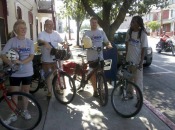
This summer, Mike (second from left) biked on the Tour de Frack with Ping Pirrung , Jason Bell and Thomas Jefferson.
Mike also biked from Butler to Washington, DC, this summer with others in the Tour de Frack, which he helped organize to protest fracking, collect stories from those in harmed communities and to educate others, particularly legislators.
As we ascend a hill, trying to get a better view of a fracking rig, an enormous water tanker suddenly appears, coming toward us. Mike keeps to the far right as it passes and turns into the access road to the industrial site. The operation, with generators running incessantly, is in a large field but directly behind a small house on the rural road. The homeowner complained to officials from the Pennsylvania Department of Environmental Protection when he measured the distance from his property and found it to be 122 feet closer than the newly mandated 500 feet. The owner wanted it moved. Mike said the fracking company offered the homeowner $5,000 in exchange for a waiver of the 500-foot rule. The man declined, concerned about what he would do if his water became contaminated. The company offered him six months of water if that happened. The resident said he planned to live in the house another 30 years, so what good was a promise of six months of water. The drillers moved the site to the required 500 feet. A symbolic victory for this homeowner who still has a fracking rig basically in his back yard.
Traveling more winding, hilly roads, we pass a processing plant, an enormous industrial facility that turns fracked gas into pipeline-quality natural gas. It is at an abandoned farm and across the street from a small landfill. On the nearby hillsides are mini-mansions as well as smaller homes, all predating this facility.
Our last stop is a one-story home on Glenwood Avenue in Evans City, Pa., where Vincent and Ruth Watson have lived since 1971. They used to look out their living room window onto silos, a dairy farm and cows. In 2011, they noticed construction activity on the Marburger Farm Dairy land and thought a new barn was being built. Soon, though, they learned that Marburger had leased the land to a company that would frack for natural gas within hollering distance of the couple’s front door.
Now they look out onto a drilling rig. This site was built before the state set the minimum 500-foot buffer. Connoquenessing Creek flows at the end of this narrow road. The houses across the street from the Watsons’ are a couple hundred feet from the drilling site. The homeowners at the end of the street tried to refinance, but the bank turned them down because of their proximity to the drilling. If the Watsons wanted to move, they said, they doubt they would be able to sell their home.
Initially, the round-the-clock bright lights from the site were aimed toward the houses; after complaints, they were pointed toward the farm. When the company was drilling the wells, “a glass on the table would shake,” Vincent said. The actual fracking was not very noticeable, but “the noise was unbelievable” during the 48 hours the previous week when the company had been burning off gases from the rig, or flaring. Ruth said she could smell gasoline the first day of flaring but nothing the second day. An elderly neighbor couldn’t sleep because of the noise. The Watsons have no idea when or if the flaring will begin again. “Imagine waking up at 5 a.m. and all the light in the room is flickering. You see the window is red,” and “if you go in the back yard, you can read at night,” Vincent said. Here’s the video Vincent took during the flaring.
Flares emit air pollutants, depending on the chemical composition of the natural gas and byproducts formed from the chemicals used to frack the wells. Flaring can exacerbate asthma and trigger other respiratory and health problems. It also contributes to climate change, because natural gas is mostly methane, which is 21 times as efficient at trapping heat in the atmosphere as carbon dioxide.
Vincent said in a later email that he was anxious during the flaring. He had the air quality tested, but the emissions were within legal limits. He said the noise and lights upset the other residents the most — and “the fact that we had no say at all. If someone burns trash or has a loud party, one can complain — but not this.”
“Basically anything they’ve said has been a lie,” said Vincent, a retired Earth and space science teacher. He has never been able to get information on when the drilling or the fracking or the flaring will start or end.
Part of his thinking on fracking’s dangers is from the long view he takes as a science teacher. The Earth’s resources are finite; everyone on the planet is intricately connected. In the 1970s, he said, PCBs used in far-off lands showed up in polar bear tissue. “At the rate we’re going at this point,” he said, “we’re going to pollute the whole world.” Drilling companies are forcing a secret combination of known hazardous or carcinogenic chemicals into the water cycle — and that should be of concern whether one has public water or well water, he said.
His message to Marylanders? “Don’t do it.”
–elisabeth hoffman
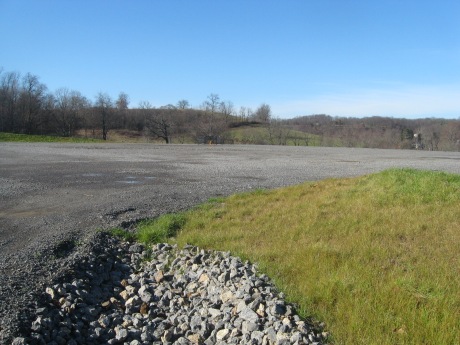
The drilling rig and other equipment has been removed from this fracking site in Butler County. A gate is at the entrance to the site.
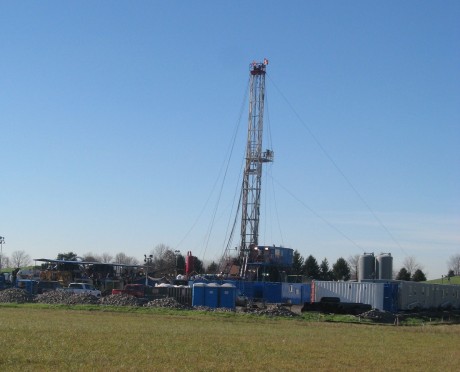
A drilling rig and other equipment is the backyard view for a homeowner
who insisted on the 500-foot buffer.
the bridge to a hotter future
December 10, 2012

Conference speakers and participants want a fracking moratorium in Maryland.
Holding the banner are, from left, Mike Tidwell, Dana Shimrock,
Heather Mizeur, Joe Romm and CCAN organizers Megan Jenny and Kelly Trout.
//photo from Delegate Mizeur’s facebook page.
The fossil fuels economy is a Ponzi scheme, author and blogger Joe Romm said Saturday at Chesapeake Climate Action Network’s statewide Conference on Fracking Risks and Action in Maryland. Instead of the typical Ponzi scheme, in which we stay rich by fooling the next guy, “we are staying rich by taking and destroying resources our kids would depend on. … We are hurting our kids … so this is much worse than other Ponzi schemes.” We are depleting the water, air and land, he said – behavior that has to collapse eventually. And natural gas, once thought to be the bridge fuel to the future, is instead a “bridge to nowhere” and just a part of this Ponzi scheme. “We have to stop building fossil fuels infrastructure this decade,” he said.
Romm was one of four speakers on a morning panel at the all-day conference at the University of Baltimore that examined the risks of hydraulic fracturing and laid out the case for a moratorium on the drilling process in Maryland unless it can be shown to be safe.
Mike Tidwell, executive director of CCAN, said the gas industry always points to winners but overlooks the losers. “How many losers? We don’t know.” That’s why Maryland first needs a thorough study of the economic, environmental and health effects, from tourism to tap water to truck traffic, he said.
Delegate Heather Mizeur, who delivered a keynote address at the conference, emphasized that Maryland is the only state that sits on top of Marcellus Shale but hasn’t rushed into fracking. “We have the opportunity to act first,” she said, instead of having to clean up an environmental mess afterward. “We will not drill first and ask questions later.”
Fracking involves drilling about a mile underground and then turning the drill and heading another mile or so sideways through shale rock. Drillers use explosives to begin shattering the rock, then send a mixture of water, silica sand and a top secret combination of toxic and often carcinogenic chemicals under high pressure to crack open the rock and release bubbles of methane trapped there. The gas and some of the toxic brew comes back up the pipe, along with radium that had been locked safely underground. Sometimes that waste is injected into underground wells, a practice linked to earthquakes. Other times it sits in wastewater pits or is spread on roads. It also has been sent through waste-treatment plants and returned in questionable condition to drinking water sources.
An executive order by Gov. Martin O’Malley stands in the way of drilling in Maryland, for now. He set up a commission to study fracking and recommend regulations, but natural gas industry lobbyists have successfully argued against a fee on land leased for drilling that would have funded a comprehensive study. Mizeur called the executive order a “temporary reprieve.”
A legislative moratorium “will not happen without you,” she told the more than 200 people attending the conference. “I’m asking each of you to make this fight your own.”
“We can keep something bad from ever happening,” she said.
In the afternoon, those at the conference could attend two of three breakout sessions: how to make the fracking moratorium happen; debunking fracking myths; and fracking’s cost to the environment and clean energy alternatives.
(At least half a dozen CCICH members attended the conference, so I hope others will include comments about the sessions they attended or any other parts of the conference. I attended the latter two sessions.)
The morning panel members, as well as those during afternoon sessions, talked about the health, climate, community and legal ramifications of fracking. Others spoke of advances in renewable energy, such as solar and wind. Emma’s Revolution made an unscheduled appearance, singing “Feel the Wind,” a song the two musicians wrote to encourage Maryland legislators to pass offshore wind legislation.
Several speakers talked of the folly of building the infrastructure for a global natural gas economy that, according to the International Energy Agency, will warm the planet a catastrophic 6 degrees C (for those of us in the U.S., that’s about 11 degrees F). Ted Glick, national program coordinator of CCAN, called natural gas a “bridge fuel to worldwide climate catastrophe.” (During a Mitt Romney campaign stop in Virginia shortly after Hurricane Sandy, Glick hoisted a banner that said “End Climate Silence” and yelled, “What about climate? That’s what caused this monster storm,” before being drowned out by audience boos and chants of “USA! USA!” and hauled out of the area.) Glick said that if fracking expands worldwide, the atmosphere would be headed for 650 parts per million of carbon dioxide and other greenhouse gases by the end of the century, far above the 350 ppm that made civilization possible. Although the burning of natural gas emits less CO2 than coal or oil, it emits methane during drilling and venting, from compressor stations and along leaking pipelines. Shorter-lived methane is about 20 times more efficient at trapping heat than CO2, but averaged over 20 years, it is 72 times worse for the climate, Glick said.
Suzanne Jacobson, a nurse at Frederick MemorialHospital, and Veronica Coptis, a community organizer for Mountain Watershed Association in southwest Pennsylvania outlined the health problems in communities living with fracking. Doug Shields, the former Pittsburgh councilman, talked about leading that city’s efforts to pass a ban on fracking based on community rights rather than zoning. So far, no company has sued. He said the nation needs political leadership similar to that shown by President Kennedy, who set a timeframe for getting to the moon.
Panel member Dana Shimrock leased 50 acres of her land in Western Maryland, a decision she now regrets. For a year, she resisted industry representatives, but as her neighbors signed leases, she eventually relented, thinking that fracking would be similar to conventional gas drilling. When she asked what was in the fluid used to frack wells, she was told water and sand. No mention was made of the hazardous chemicals. She also was told the drilling footprint would be about an acre. In reality, the footprint of Pennsylvania drill pads is six to 10 acres, she said. She received $5 an acre, but the lease was eventually flipped for $10,000 an acre. The CEO of Chief Oil & Gas is very wealthy, she said, but he made his money from flipping leases, not from extracting natural gas. She has also learned much about those harmed by fracking in Pennsylvania, including an organic farmer whose land is now nearly worthless. “Banks don’t want to have anything to do with land with leases,” she said, or even adjacent properties.
Paul Roberts, a farmer and winery owner in GarrettCounty and founder of Citizen Shale, has not leased his family’s land, but the narrow road that runs in front of his house would be filled with diesel trucks hauling millions of gallons of water and fracking waste. The nearby land would be covered with well pads, each with eight or so wells, along with compressor stations and pipelines. “You’re probably thinking this is a personal thing,” he said, “We’re over it being personal. … If we go down this road and subject another generation to fossil fuels, it’s game over for the planet.”
Invoking Bill Clinton, he said the arithmetic of shale gas doesn’t add up. To produce enough natural gas to fill half the energy needs of the nation by 2035, as the industry plans to do, 35,000 to 40,000 wells would have to be drilled every year. In 2012, however, 18,000 to 20,000 were drilled, far short of the goal. Yet those wells already have brought environmental degradation to Pennsylvania, West Virginia and states in the southwest United States. He said we would have to fell every fifth tree in Pennsylvania to meet the goal. Also, because natural gas is not easily stored, the industry has to increase demand by promoting gas for vehicles, even though this would require an enormous investment in infrastructure, and try to set up ports for export. At the same time, however, the Energy Information Administration has drastically lowered estimates of how much gas is contained in the Marcellus Shale.
Because of low gas prices, many drillers have let leases lapse in Western Maryland. Chevron is the lone company remaining, he said. “We have time to make the right decision,” Roberts said.
Diana Dascalu-Joffe, the senior general counsel of CCAN, discussed the myth that the industry is highly regulated. The so-called Halliburton loophole, for example, exempts the gas industry from oversight provisions of the Safe Drinking Water Act, the Clean Water Act, the Resource Conservation and Recovery Act (RCRA), the Comprehensive Environmental Response, Compensation and Liability Act (CERCLA) and others. In addition, Maryland regulations for the oil and gas industry haven’t been amended since 1993, so they don’t even address fracking. Maryland also has trade secret exemptions that would fail to protect workers or communities. Under existing laws, she said, the Maryland Department of the Environment has the “discretion” to allow drilling permits within 1,000 feet of water sources, streams, schools, populations. She said MDE should not have the ability to allow drilling so close to those areas. “An unregulated industry is a dangerous industry,” she said.
Lester Brown, founder and president of the Earth Policy Institute, seemed sharp but also a bit weary on what he said was his 1,867th talk—a factoid he knows because he’s working on an autobiography. “We talk about saving the planet, but it’s our civilization that’s in danger,” he said. The environmental trends show trouble on many fronts, from aquifer depletion, deforestation, climate change and overpopulation.
Food, he said, is the weak link. The combination of population growth and people “moving up the food chain” to diets high in meat, milk and eggs has put extreme pressure on earth’s resources, particularly water. Many countries are overpumping aquifers, so water will be the main constraint for more food.
Farmers also face climate change. As a former farmer, Brown said, he always faced the variability of weather. Eventually normal would return. “Now there’s no normal to go back to. Farmers don’t know how to plan,” he said. For each 1 degree C rise in average global temperatures, grain yields decline 10 percent. Agriculture evolved during 11,000 years of climate stability, he said. “That climate system is no more.” Soil erosion, a byproduct of overplowing and overgrazing, will be another constraint on food production. Grain prices are already rising, and families in Ethiopia, India, Nigeria and other nations plan for foodless days.
We need to stabilize the climate, but cutting carbon and other greenhouse emissions 80 percent by 2050 is too late, he said. Instead we need a massive mobilization to cut emissions 80 percent by 2020. He sees hope in many places: coal plants are closing, auto sizes peaked in 2007 and cities are instituting bike sharing programs. Wind farms provide 40 to 50 percent of the energy in three German states and 20 percent of the electricity in Iowa and South Dakota. He said wind energy can “scale up” like no other energy form, from 100 megawatts to 10,000 megawatts. “We are now in the early phase of what I call the great transition” from fossil fuels, he said, and he’s confident that wind energy will “become the centerpiece of the new energy economy.”
He said we will need a massive restructuring similar to 1942, when this nation shifted to a wartime footing. “If we could restructure the U.S. industrial economy in 1942 … then certainly we can restructure the energy economy today.”
“Time is our scarcest resource,” he said, because we need to shift to this new energy economy “before climate change spirals out of control.” He urged everyone to have a stake in future civilization. “We can’t sit around and hope someone will save the future for us.”
Read a Washington Post article about the conference here.
–elisabeth hoffman
